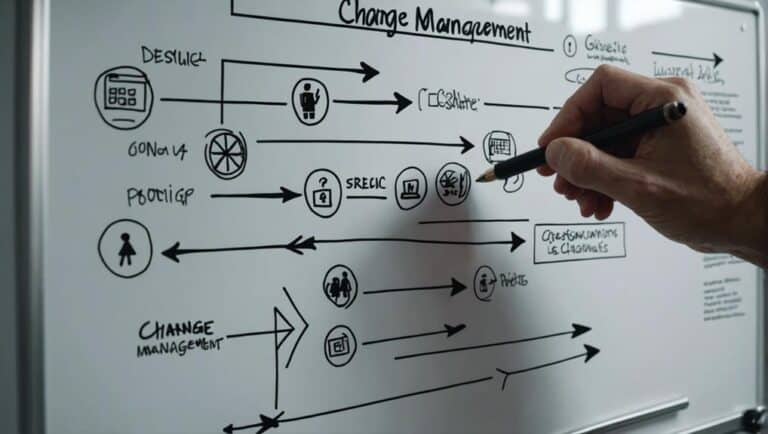You might wonder how to align change management with the fast-paced nature of Agile projects. Embracing change in Agile environments isn't just about adapting; it's a strategic approach that can revolutionize the way organizations evolve.
Understanding the intricacies of Agile methodologies and how they intertwine with change management practices is pivotal. Let's explore how fostering adaptability and nurturing a culture of continuous improvement can lead to successful transformations in dynamic environments.
Key Takeaways
- Embrace flexibility and adaptability to navigate changes effectively in Agile environments.
- Cultivate a culture of continuous improvement and transparency for successful Agile change management.
- Establish clear goals, encourage open communication, and enhance collaboration for Agile change success.
- Utilize Agile tools, prioritize team collaboration, and leverage expertise to drive successful change in Agile environments.
Understanding Agile Methodologies
To truly grasp the essence of Agile methodologies, immerse yourself in the world of iterative and adaptive project management practices. Agile methodologies emphasize flexibility, continuous improvement, and collaboration at their core. In project management, Agile stands out for its ability to adapt to changing requirements, ensuring that teams can deliver working software frequently. By focusing on collaboration between business stakeholders and development teams, Agile fosters daily interactions that align projects with customer needs effectively. This collaborative approach not only enhances communication but also promotes a shared understanding of project goals and priorities.
Continuous improvement lies at the heart of Agile methodologies, driving teams to prioritize the early and frequent delivery of valuable software. This emphasis on adapting to changing requirements not only provides a competitive advantage in the market but also encourages teams to embrace a culture of innovation and creativity. By adopting Agile methodologies, organizations can shift towards an entrepreneurial mindset, instilling a focus on performance and sustained success.
Importance of Flexibility in Change
Embrace the dynamic nature of Agile environments by recognizing that the importance of flexibility in change can't be overstated. In Agile settings, Change Management practices are crucial for ensuring project success. Here's why flexibility in change is vital:
- Adaptive Responses: Flexibility enables you to adapt quickly to changing requirements and priorities, ensuring that your project stays on track even when faced with uncertainties.
- Efficient Adjustments: Being able to pivot rapidly in response to feedback and new information allows for efficient adjustments to project plans, leading to improved outcomes.
- Responsive Approach: By embracing flexibility, you foster an adaptive and responsive approach to change, which is essential in Agile environments where project landscapes can shift rapidly.
In Agile environments, the ability to be flexible in change management practices not only enhances adaptability but also plays a significant role in achieving successful project outcomes. Stay agile, stay flexible, and watch your projects thrive.
Strategies for Adaptability
In navigating Agile environments, fostering adaptability through strategic change management approaches is key to staying ahead of rapidly evolving needs. Embracing an Agile approach to change requires a mindset geared towards adaptability, where continuous learning plays a crucial role. By prioritizing ongoing education and improvement, teams can better respond to shifting requirements and market demands.
Flexible communication channels are essential for fostering adaptability in Agile change management. Creating open lines of communication and feedback mechanisms allows for quick adjustments and real-time decision-making. This adaptability is further strengthened through cross-functional collaboration, where different departments work together towards shared goals. By breaking down silos and encouraging knowledge sharing, teams can leverage diverse perspectives and expertise to navigate change effectively.
Ultimately, adaptability in Agile change management hinges on the ability to adjust plans based on feedback and insights. By embracing a culture of flexibility, continuous learning, and collaboration, organizations can position themselves to thrive in dynamic and ever-changing environments.
Fostering a Culture of Continuous Improvement
Navigating Agile environments successfully hinges on fostering a culture of continuous improvement, promoting transparency, feedback, and learning from failures. To achieve this, consider the following:
- Encouraging Open Communication: In Agile environments, open communication is vital for fostering continuous improvement. Encourage team members to share ideas, concerns, and feedback openly to drive innovation and growth.
- Implementing Feedback Loops: Regular retrospectives and feedback loops are crucial for identifying areas of improvement promptly. By gathering feedback from team members and stakeholders, you can adapt quickly and enhance processes effectively in Agile settings.
- Creating Space for Experimentation: Cultivating a safe environment for experimentation and innovation is key to continuous improvement in Agile teams. Encourage individuals to try new approaches, learn from both successes and failures, and iterate on processes to foster a culture of innovation and growth.
Overcoming Challenges in Agile Environments
You need to address challenges head-on in Agile environments.
Team Collaboration Strategies, Adaptability to Change, and Communication in Agile are crucial for overcoming obstacles effectively.
Team Collaboration Strategies
To foster effective team collaboration in agile environments, implementing clear communication channels and utilizing collaborative tools is essential for overcoming challenges and ensuring project success. Here are three key strategies to enhance team collaboration:
- Daily Stand-up Meetings: Conduct brief daily meetings to discuss progress, roadblocks, and next steps, ensuring alignment and transparency within the team.
- Utilize Collaborative Online Tools: Employ tools like Jira, Trello, or Asana for real-time tracking and visibility into project tasks, facilitating seamless collaboration and task management.
- Pair Programming and Peer Code Reviews: Embrace these strategies to ensure code quality, foster knowledge sharing, and promote a culture of collective ownership and continuous improvement among team members.
Adaptability to Change
In agile environments, embracing change as an ongoing process fosters adaptability and drives innovation to overcome challenges effectively. Being agile means being flexible and responsive to the ever-evolving project requirements and priorities. It involves iterative problem-solving and a willingness to adjust plans based on new information. Successful adaptation in these environments heavily relies on effective communication and collaboration among team members. By maintaining open channels of communication and fostering a culture of collaboration, agile teams can navigate through uncertainties and complexities more efficiently. Embracing change as a constant not only enhances adaptability but also leads to increased innovation and improved project outcomes.
| Key Points | Description |
|---|---|
| Agility | Being flexible and responsive to changes in project requirements and priorities. |
| Adaptability | Iterative problem-solving and adjusting plans based on new information. |
| Communication | Effective communication among team members is crucial for successful adaptation. |
| Collaboration | Fostering a culture of collaboration enhances team dynamics in agile environments. |
Communication in Agile
Communication challenges in Agile environments can present obstacles due to the rapid nature of iterative development cycles. To overcome these obstacles and ensure project success, consider the following:
- Frequent Interactions: Encourage regular communication among cross-functional teams to stay aligned on project goals and priorities.
- Clear Goals: Define and communicate clear objectives to ensure everyone understands their roles and responsibilities.
- Transparency: Promote open and honest communication to build trust within the team and foster collaboration.
Key Elements of Agile Change Management
Let's explore the essential components of Agile Change Management, focusing on the tools that facilitate change and the importance of team collaboration in driving successful transformations.
By leveraging Agile tools for change, you can streamline the process and adapt more swiftly to evolving requirements.
Encouraging team collaboration in change efforts cultivates a shared sense of ownership and commitment, fostering a culture of adaptability and continuous improvement.
Agile Tools for Change
Utilize agile tools for change management to enhance visualization, decision-making, and collaboration in dynamic business environments.
- SharpCloud: This tool aids in visualizing business environments and supports decision-making processes in agile change management.
- Online Collaboration Platforms: These platforms facilitate virtual operations and enable tracking of advancements in change initiatives, promoting effective collaboration.
- Champions: Within organizations, champions are crucial in driving transformation and effectively tracking innovations in agile change management.
Team Collaboration in Change
To foster successful change implementation in agile environments, prioritize team collaboration as a fundamental element that drives innovation and adaptability throughout the change process.
Effective communication within teams is essential for aligning everyone towards change goals. Collaborative decision-making empowers team members to contribute diverse ideas, fostering a sense of ownership in the change journey.
In agile change management, cross-functional collaboration leverages varied expertise for innovative solutions. Emphasizing team collaboration in agile change management enables rapid adaptation and responsiveness to evolving requirements and feedback.
Best Practices for Thriving in Change
To thrive in change successfully in Agile environments, engage early with change managers to align strategies with project goals and timelines. This proactive approach ensures that everyone is on the same page from the outset, setting the foundation for effective change implementation.
Here are three best practices to help you thrive in change within Agile environments:
- Maintain Consistent Communication: Keep all stakeholders informed and aligned throughout the change process. Clear and open communication channels help address concerns, gather feedback, and ensure that everyone feels included in the transition.
- Secure Senior Leader Engagement: Gain support and guidance from senior leaders to champion change initiatives. Their involvement not only provides a top-down endorsement but also helps navigate any roadblocks that may arise during the change process.
- Aim for Early Wins: Focus on achieving quick wins to demonstrate the benefits of Agile change management practices. Celebrating early successes builds momentum, boosts morale, and reinforces the value of incremental changes in driving positive outcomes.
Frequently Asked Questions
How Do You Manage Change Management in Agile?
To manage change in Agile, focus on communication strategies for clear updates, team collaboration for shared goals, stakeholder engagement for support, iterative feedback for adjustments, and continuous improvement for growth. Embrace change with agility.
What Is the Agile Change Management Program?
In an Agile Change Management Program, stakeholders engage through robust communication strategies. Continuous improvement and flexibility drive the iterative approach. Risk management is key with adaptability. Team collaboration, training, and feedback loops enhance success.
How Do You Handle Changes in Requirements Within an Agile Development Environment?
You handle changes in requirements within an agile development environment by embracing scope creep, fostering stakeholder communication, prioritizing backlog, practicing continuous integration, and refining sprint planning. Stay agile, stay ahead!
Does Agile Have Change Control?
Yes, Agile does have change control mechanisms in place. These processes focus on assessing change impact, controlling changes, and aligning priorities. Agile's adaptability and collaboration help mitigate change resistance while ensuring flexibility and effective communication throughout the project.
Conclusion
You've learned how Agile Change Management can help organizations thrive in dynamic environments.
Are you ready to embrace flexibility, collaboration, and continuous improvement to drive growth and efficiency in your organization?
With the right strategies and best practices in place, navigating change in Agile environments can be a rewarding journey.
So, what're you waiting for? Let's embark on this transformational adventure together!





